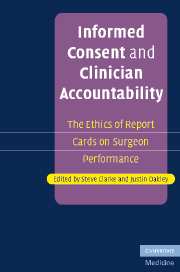Introduction: Accountability, informed consent and clinician performance information
Published online by Cambridge University Press: 08 August 2009
Summary
Every few years a rogue doctor comes to prominence in the international media. Some, like James Wisheart, the senior paediatric cardiac surgeon at the centre of the Bristol Royal Infirmary Scandal are deemed to be plainly incompetent to perform the operations that they have been undertaking. Others, like Jayant Patel, the surgeon at the centre of the recent scandal at the Bundaberg Base Hospital in Queensland, Australia, appear from the evidence to combine incompetence to perform operations undertaken with a willingness to place their patients in situations of unnecessary risk. The focus of the media on such sensational cases can obscure the fact that there are many less newsworthy, but nevertheless incompetent, physicians practising. According to Atul Gawande, science and technology writer for the New Yorker:
In medicine, we all come to know such physicians: the illustrious cardiologist who has slowly gone senile and won't retire; the long-respected obstetrician with a drinking habit; the surgeon who has somehow lost his touch.
(2002, p. 89)When people are faced with the prospect of having to undergo surgery, they invariably like to be reassured that they will receive a high standard of care. There are many variables that contribute to the determination of the standards of care in a surgical operation. One of them is surgeons' performance ability. Surgeons vary considerably in their ability to conduct particular operations. Some are outstanding performers, some are adequate performers and some are inadequate.
- Type
- Chapter
- Information
- Informed Consent and Clinician AccountabilityThe Ethics of Report Cards on Surgeon Performance, pp. 1 - 22Publisher: Cambridge University PressPrint publication year: 2007



